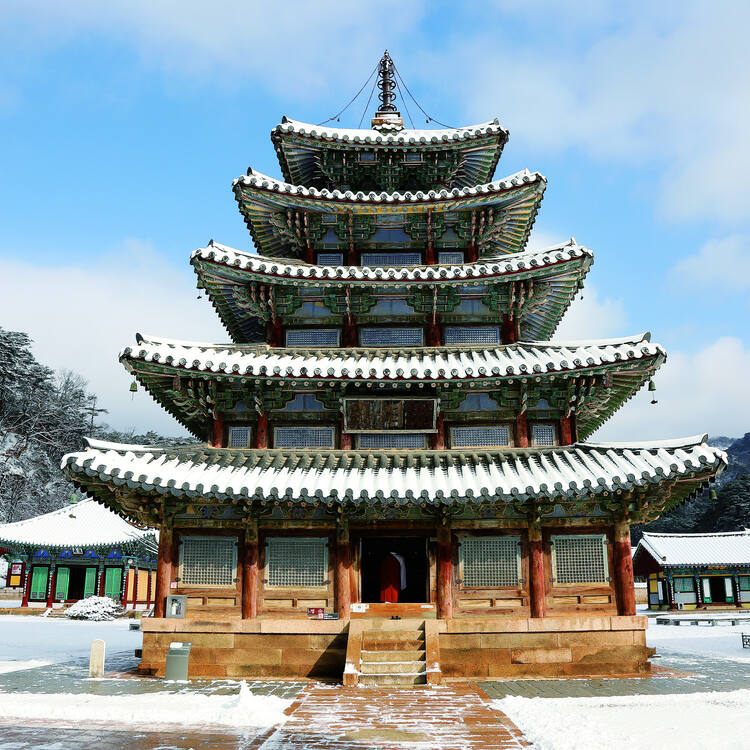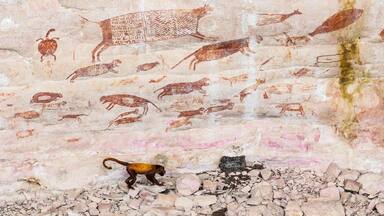Sansa, Buddhist Mountain Monasteries in Korea
Sansa, Buddhist Mountain Monasteries in Korea
The Sansa are Buddhist mountain monasteries located throughout the southern provinces of the Korean Peninsula. The spatial arrangement of the seven temples that comprise the property, established from the 7th to 9th centuries, present common characteristics that are specific to Korea – the ‘madang’ (open courtyard) flanked by four buildings (Buddha Hall, pavilion, lecture hall and dormitory). They contain a large number of individually remarkable structures, objects, documents and shrines. These mountain monasteries are sacred places, which have survived as living centres of faith and daily religious practice to the present.
Description is available under license CC-BY-SA IGO 3.0
Sansa, monastères bouddhistes de montagne en Corée
Les Sansa sont des monastères bouddhistes de montagne disséminés dans les provinces méridionales de la péninsule coréenne. L’aménagement spatial des sept temples qui composent le bien, fondés du VIIe au IXe siècle, présente des traits communs qui sont spécifiques à la Corée – le madang (cour ouverte) entouré de quatre bâtiments (salle du Bouddha, pavillon, salle de lecture et dortoir). Ils contiennent un grand nombre de structures, d’objets, de documents et de sanctuaires remarquables. Lieux sacrés, les monastères de montagne ont survécu jusqu’à nos jours en tant que centres religieux vivants, avec une pratique quotidienne de la foi.
Description is available under license CC-BY-SA IGO 3.0
سانسا، أديرة بوذية جبلية في كوريا
"السانسا" هي أديرة بوذية جبلية منتشرة في الأقاليم الجنوبية لشبه الجزيرة الكورية. ويجسّد ترتيب أماكن المعابد السبعة التي يتألف منها الموقع والمبنية بين القرنين السابع والتاسع، سمات شائعة تتميز بها كوريا ومنها مثلاً "الساحة المفتوحة" المحاطة بأربعة مبانٍ، وهي: قاعة بوذا، والجناح، وقاعة القراءة، والمنام. إذ تحتوي على عدد كبير من البُنى والقطع والوثائق والأضرحة المميزة. وقد نجت الأماكن المقدسة والأديرة الجبلية حتى يومنا هذا كمراكز دينية تنبض بالحياة وتُمارس فيها العقائد الدينية يوميّاً.
source: UNESCO/CPE
Description is available under license CC-BY-SA IGO 3.0
山寺,韩国佛教名山寺庙
山寺是指位于朝鲜半岛南部各省的佛教山寺院。遗产地由7座寺庙组成。这些建于7-9世纪的庙宇的空间布局, 呈现了韩国寺庙建筑的特色共有特征——开放的庭院, 两侧为佛厅、亭子、讲经堂和宿舍。它们包含了大量别具特色的结构、物件、文档和庙宇。这些山寺是神圣的地方,作为信仰和日常宗教实践的中心延续至今。
source: UNESCO/CPE
Description is available under license CC-BY-SA IGO 3.0
Санса, буддийские горные монастыри в Корее
Санса – это буддийские горные монастыри, разбросанные по территории южных провинций Корейского полуострова. Территориальное расположение семи храмов, составляющих этот объект, возведенных с VII по IX века, имеет общие черты, характерные для Кореи: «маданг» (открытый двор), окруженный четырьмя зданиями (зал Будды, павильон, читальный зал и общежитие). Они содержат большое число структур, объектов, документов и выдающихся святилищ. Будучи священными местами, горные монастыри по сей день выполняют функцию действующих ежедневно практикующих обряды и ритуалы религиозных центров.
source: UNESCO/CPE
Description is available under license CC-BY-SA IGO 3.0
Sansa, monasterios budistas de las montañas de Corea
Los sansa son monasterios budistas dispersos en las montañas de las provincias meridionales de la Península de Corea. Fundados entre los siglos VII y IX, los siete monasterios-templos integrantes del sitio poseen rasgos comunes, típicamente coreanos, en su distribución espacial. Constan de un patio central cubierto denominado madang, que está flanqueado por cuatro edificios: la estancia de Buda, el pabellón, la sala de lectura y el dormitorio. Poseedores de un gran número de elementos arquitectónicos, objetos, documentos y santuarios primorosos, estos monasterios han subsistido hasta nuestros días y siguen siendo lugares donde se practica a diario la religión budista.
source: UNESCO/CPE
Description is available under license CC-BY-SA IGO 3.0
Outstanding Universal Value
Brief synthesis
Sansa consists of seven Buddhist mountain monasteries—Tongdosa, Buseoksa, Bongjeongsa, Beopjusa, Magoksa, Seonamsa and Daeheungsa—located throughout the southern provinces of the Korean Peninsula. The seven monasteries established from the 7th to the 9th centuries have functioned as centres of religious belief, spiritual practice, and daily living of monastic communities, reflecting the historical development of Korean Buddhism. Sansa has accommodated diverse Buddhist schools and popular beliefs within its precinct, and many of its notable historic structures, halls, objects and documents reflect such assimilating features of Korean Buddhism. The distinctive intangible and historical aspects of Korean Buddhism can be recognized in the continuous traditions of self-sufficient temple management, education of monks, and coexistence of meditative practice and doctrinal studies of Korean Seon Buddhism. These mountain monasteries are sacred places, which have survived to the present as living centres of faith and religious practices despite suppression during the Joseon Dynasty and damages caused by wars and conflicts over the years.
Criterion (iii): Buddhism has a long history that has traversed a number of historical eras in the Korean Peninsula. The seven mountain monasteries – Tongdosa, Buseoksa, Bongjeongsa, Beopjusa, Magoksa, Seonamsa and Daeheungsa – offer a distinctively Korean instantiation of Buddhist monastic culture from the 7th century to the present day. These mountain monasteries are sacred places and provide an exceptional testimony to their long and continuing traditions of Buddhist spiritual practice.
Integrity
Together the seven temples contain the elements necessary to express the Outstanding Universal Value of Korean Buddhist mountain monasteries, including their mountain settings, well-preserved buildings for religious practice and daily living, worship halls and shrines, meditation areas, monastic academy spaces and dormitories for monks. Few pressures threaten the components and they are intact, free of major losses and alterations during the modern period, and retain their original functions, despite changes through history.
Authenticity
The authenticity of the serial property is based on the long and continuing uses of the components for Buddhist spiritual practices and rituals, and is based on their location and setting; traditions, techniques and management skills; and intangible heritage. The architectural elements have been carefully maintained according to principles of repair and restoration, using traditional construction techniques, although the function of some buildings have changed to support the operations of the temples. The religious traditions and functions of the Buddhist temples maintain a high degree of authenticity.
Protection and management requirements
The seven temples are all being protected and managed as State or City/Province designated Cultural Heritage under the Cultural Heritage Protection Act. Modern constructions to facilitate continuing use and developments around the temples are strictly controlled. Each of the seven components is also protected by the Korean Traditional Temples Preservation and Support Act.
Cultural Heritage Zones and Historical and Cultural Environment Protection Zones established by the Cultural Heritage Protection Act are in place for each of the components and their buffer zones. The Cultural Heritage Protection Act applies within areas of 500-metres of the outer boundary of each Cultural Heritage Zone. Heritage Impact Assessments are prepared within the provisions of the Cultural Heritage Protection Act. Each temple has various designated elements (including artworks, relics and architecture) at the national or provincial level.
The ‘Conservation and Management Plan for Sansa, Buddhist Monasteries in Korea’ is in place, and the management system and conservation strategy will be overseen by ‘Sansa Conservation and Management’, with representation from religious and government authorities. Staff are provided for administration, conservation management, monitoring, research and promotion, as well as the monks, temple management staff, cultural heritage management staff and cultural tourism guides.
Each temple is under the responsibility of a chief abbot. The Cultural Heritage Administration and provincial governments are responsible for the management of cultural heritage, and the development and implementation of related projects. The Laity Association of each temple participates in volunteer work to support Buddhist practices, maintaining the temple landscapes and cleaning the temples. Visitor infrastructure is provided at each temple.
The Cultural Heritage Administration formulates comprehensive 5-year plans for the conservation and management of the temples in consultation with provincial governments. There is a Cultural Heritage Maintenance Plan for Buseoksa and Seonamsa temples, and plans for the remaining components will be established in 2018-2020.


